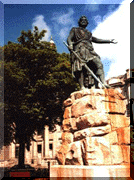The Clan Wallace

- Branches:Wallace of Cairnhill, Wallace of Cessnock, Wallce of Craigie, Wallace of Elderslie, Wallace of Kelly, Wallace of Riccarton.
- Arms: Gules, a lion rampant Argent within a bordure countercompony of the Last and Azure.
- Badge: Issuant from a crest coronet of four (three visible) strawberry leaves Or, a dexter arm vambraced, the hand brandishing a sword all Proper.
- Motto: Pro libertate (For Freedom)
- Gaelic Name: Uallas
- Tartans: Wallace, Wallace (green), Wallace (green).
The term 'Welsh' appeared in the earlier English form of Weallise
and the mediaeval form Wallensis, and was applied to the British peoples
from Strathclyde in Scotland to Brittany in France who spoke that branch of
the Celtic family of languages now represented by Breton and Welsh. In the
12th century the Kings of Scots were still addressing their subjects as
distinct ethnic groups: French and English, Scots and Welsh. Hence the
surnames Inglis, Scott and Wallace. The ancient captial of Strathclyde is
still remembered as Dumbarton, the Fortress of the Britons.

In the second half of the 12th century a man called Richard, defined as a
Wallace, obtained lands in Ayrshire, which belongs to the former Kingdom of
Strathclyde. His property was called Richardston, now Riccarton; and his
great-grandson, Sir Malcolm Wallace, received the lands of Elderslie in
Renfrewshire. Such was the background of Malcolm's son William, who was to
evoke a national spirit which united so many disparate peoples and to earn
his place as Scotland's greatest patriot.
The Clan Wallace did not descend from Sir William Wallace but from the
Riccarton Branch. The current chief of the clan, Ian Wallace, is recognized
by the Lord Lyon King of Arms as the head of all branches, Renfrewshire,
Riccarton, and Craigie.








Copyright © DISCscribe Ltd. 1997 - All rights reserved.










